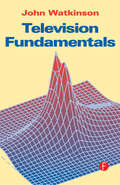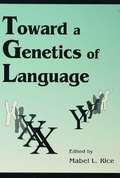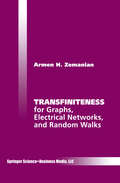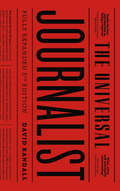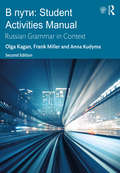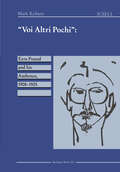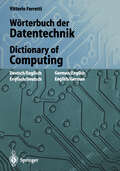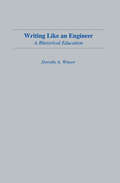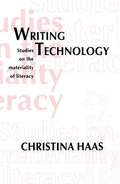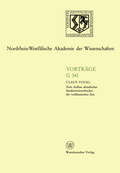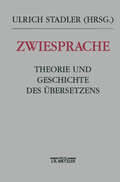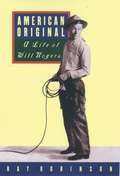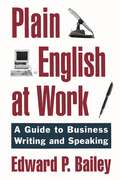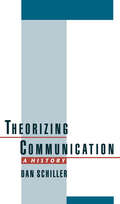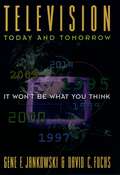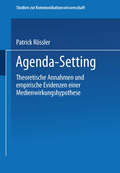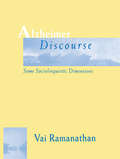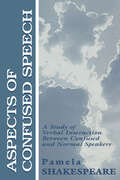- Table View
- List View
Television Fundamentals
by John WatkinsonTelevision today means moving pictures in colour with sound, brought to the viewer by terrestrial or satellite broadcast, cable or recording medium. The technique and processes necessary to create, record, deliver and display television pictures form the major part of this book. Television Fundamentals is written in clear English, with a minimum of mathematics. Readers are taken, in a logical sequence of small steps, through the fundamental principles of the subject, with practical applications and a guide to troubleshooting included. Encoding, decoding, recording and transmission are treated in depth.John Watkinson is an independent consultant in digital video, audio and data technology. He is a Fellow of the AES and presents lectures, conference papers and training courses worldwide. he is the author of numerous other Focal Press books, including: Compression in Video and Audio, The Art of Digital Audio and The Art of Digital Video (now in their second editions), the Art of Data Recording, An Introduction to Digital Audio, An Introduction to Digital Video, The Digital Video Tape Recorder and RDAT.
Television Fundamentals
by John WatkinsonTelevision today means moving pictures in colour with sound, brought to the viewer by terrestrial or satellite broadcast, cable or recording medium. The technique and processes necessary to create, record, deliver and display television pictures form the major part of this book. Television Fundamentals is written in clear English, with a minimum of mathematics. Readers are taken, in a logical sequence of small steps, through the fundamental principles of the subject, with practical applications and a guide to troubleshooting included. Encoding, decoding, recording and transmission are treated in depth.John Watkinson is an independent consultant in digital video, audio and data technology. He is a Fellow of the AES and presents lectures, conference papers and training courses worldwide. he is the author of numerous other Focal Press books, including: Compression in Video and Audio, The Art of Digital Audio and The Art of Digital Video (now in their second editions), the Art of Data Recording, An Introduction to Digital Audio, An Introduction to Digital Video, The Digital Video Tape Recorder and RDAT.
Toward A Genetics of Language
by Mabel L. RiceThe past decade has brought important new advances in the fields of genetics, behavioral genetics, linguistics, language acquisition, studies of language impairment, and brain imaging. Although these advances are each highly relevant to the determination of what a child is innately prepared to bring to language acquisition, the contributing fields of endeavor have traditionally been relatively self-contained, with little cross communication. This volume was developed with the belief that there is considerable value to be gained in the creation of a shared platform for a dialogue across the disciplines.Leading experts in genetics, linguistics, language acquisition, language impairment, and brain imaging are brought together for the purpose of exploring the current evidence, theoretical issues, and research challenges in a way that bridges disciplinary boundaries and points toward future developments in the search for the genetic and environmental bases of language acquisition and impairments. This collection provides discussions and summaries of: *breakthrough findings of the genetic underpinnings of dyslexia; *theoretical and empirical developments in the specification of a phenotype of language acquisition and impairment; *evidence of familiarity and twin concordances of specific language impairment; and*new evidence from brain imaging.It concludes with a critical response from an advocate of rational empiricism.
Toward A Genetics of Language
by Mabel L. RiceThe past decade has brought important new advances in the fields of genetics, behavioral genetics, linguistics, language acquisition, studies of language impairment, and brain imaging. Although these advances are each highly relevant to the determination of what a child is innately prepared to bring to language acquisition, the contributing fields of endeavor have traditionally been relatively self-contained, with little cross communication. This volume was developed with the belief that there is considerable value to be gained in the creation of a shared platform for a dialogue across the disciplines.Leading experts in genetics, linguistics, language acquisition, language impairment, and brain imaging are brought together for the purpose of exploring the current evidence, theoretical issues, and research challenges in a way that bridges disciplinary boundaries and points toward future developments in the search for the genetic and environmental bases of language acquisition and impairments. This collection provides discussions and summaries of: *breakthrough findings of the genetic underpinnings of dyslexia; *theoretical and empirical developments in the specification of a phenotype of language acquisition and impairment; *evidence of familiarity and twin concordances of specific language impairment; and*new evidence from brain imaging.It concludes with a critical response from an advocate of rational empiricism.
Transfiniteness: For Graphs, Electrical Networks, and Random Walks
by Armen H. Zemanian"What good is a newborn baby?" Michael Faraday's reputed response when asked, "What good is magnetic induction?" But, it must be admitted that a newborn baby may die in infancy. What about this one- the idea of transfiniteness for graphs, electrical networks, and random walks? At least its bloodline is robust. Those subjects, along with Cantor's transfinite numbers, comprise its ancestry. There seems to be general agreement that the theory of graphs was born when Leonhard Euler published his solution to the "Konigsberg bridge prob lem" in 1736 [8]. Similarly, the year of birth for electrical network theory might well be taken to be 184 7, when Gustav Kirchhoff published his volt age and current laws [ 14]. Ever since those dates until just a few years ago, all infinite undirected graphs and networks had an inviolate property: Two branches either were connected through a finite path or were not connected at all. The idea of two branches being connected only through transfinite paths, that is, only through paths having infinitely many branches was never invoked, or so it appears from a perusal of various surveys of infinite graphs [17], [20], [29], [32]. Our objective herein is to explore this idea and some of its ramifications. It should be noted however that directed graphs having transfinite paths have appeared in set theory [6, Section 4.
The Universal Journalist - Fifth Edition
by David RandallA new edition of one of the world's leading textbooks on journalism. Translated into more than a dozen languages, David Randall's handbook is an invaluable guide to the 'universals' of good journalistic practice for professional and trainee journalists worldwide.*BR**BR*Randall emphasises that good journalism isn't just about universal objectives: it must also involve the acquisition of a range of skills that will empower journalists to operate in an industry where ownership, technology and information are constantly changing. His acclaimed account challenges old attitudes and rejects cynical, sloppy journalism.*BR**BR*The updated fifth edition ensures its relevance to contemporary readers by addressing issues such as problems of 'de-skilling' in the media and new tools for digital research.
V Puti: Russian Grammar in Context
by Frank Miller Olga Kagan Anna KudymaThis highly successful program assists in the development of all the language skills (listening, speaking, reading and writing) by presenting realistic settings, situations and contexts. It consists of 12 chapters and can be used in an intermediate or advanced Russian course. V Puti offers conversational exercises, various readings (biographies, poems, literature and historical texts) and grammatical explanations and practice. All of these components reinforce Russian culture and history which enable the students to understand the Russian language in context. V Puti: Student Activities Manual is an integral part of the V Puti course. The structure matches the main textbook and provides a wealth of exercises and activities, either for class-use or homework.
V Puti: Russian Grammar in Context
by Frank Miller Olga Kagan Anna KudymaThis highly successful program assists in the development of all the language skills (listening, speaking, reading and writing) by presenting realistic settings, situations and contexts. It consists of 12 chapters and can be used in an intermediate or advanced Russian course. V Puti offers conversational exercises, various readings (biographies, poems, literature and historical texts) and grammatical explanations and practice. All of these components reinforce Russian culture and history which enable the students to understand the Russian language in context. V Puti: Student Activities Manual is an integral part of the V Puti course. The structure matches the main textbook and provides a wealth of exercises and activities, either for class-use or homework.
“Voi Altri Pochi”: Ezra Pound and his Audience, 1908–1925 (International Cooper Series in English Language and Literature)
by Mark KyburzCritical tradition has established a certain way of reading Ezra Pound, one that places the meanings of the words on the page at the centre of interest and neglects poetic communication. The present study contributes to the recent challenge to this critical orthodoxy, which has led to his canonization as a "difficult" poet, by investigating the pragmatic dimension of Pound's work. In its effort to reconstruct the dynamic communicative interface between Pound and his audiences in the early period of his career (1908-1925), this study draws on relevance theory, a recent sharpening in pragmatic theory, not so much to produce a "new" reading of his poetry, but to suggest how Pound became difficult: it is argued that the relative success and failure of his poetry to enhance cognitive and civic renewal depended on the dialectic between his presumptions of audience and the interpretive expectations and skills of his actual historical readers.
Wireless Personal Communications: The Evolution of Personal Communications Systems (The Springer International Series in Engineering and Computer Science #424)
by Theodore S. Rappaport Brian D. Woerner Jeffrey H. Reed William H. TranterWireless personal communications, or wireless as it is now being called, has arrived. The hype is starting to fade, and the hard work of deploying new systems and services for personal communications is underway. In the United States, the FCC propelled the wireless era from infancy to mainstream with a $7.7 billion auction of 60 MHz of radio spectrum in the 180011900 MHz band. With the largest single sale of public property in the history of mankind mostly complete, the resources of the entire world are being called upon to develop inexpensive, rapidly deployable wireless systems and sub scriber units for an industry that is adding s\lbscribers at greater than 50% annual rate. This growth is commonplace for wireless service companies throughout the world, and in the U.S., where as many as 7 licensed wireless service providers may be competing for cellularlPCS customers within the next couple of years, differentiators in cost, qual ity, service, and coverage will become critical to customer acceptance and use. Many of these issues are discussed in the papers included in this book.
Wörterbuch der Datentechnik / Dictionary of Computing: Englisch-Deutsch / Deutsch-Englisch English-German / German-English
by Vittorio FerrettiDer FERRETTI bietet mehr als eine Übersetzungshilfe für deutsche und englische Fachbegriffe.92.000 Stichwörter mit Kurzdefinitionen und Synonymen machen diese aktuelle Teilausgabe des erfolgreichen "Wörterbuch der Elektronik, Datentechnik und Telekommunikation" zum einzigartig umfassenden Nachschlagewerk der gesamten Informatik.Die 44.000 deutschen und 48.000 englischen Einträge decken zusätzlich die Hauptbegriffe der angrenzenden Fachgebiete und des allgemeinen Sprachgebrauchs ab.Zu insgesamt 94 Fachgebieten lassen sich alle datentechnischen Fragen schnell und kompetent lösen - ein schier unerschöpflicher Fundus für jeden, der hier nachschlägt.
Writing Like An Engineer: A Rhetorical Education (Rhetoric, Knowledge, and Society Series)
by Dorothy A. WinsorComprised of a study spanning over five years, this text looks at four engineering co-op students as they write at work. Since the contributors have a foot in both worlds -- work and school -- the book should appeal to people who are interested in how students learn to write as well as people who are interested in what writing at work is like. Primarily concerned with whether engineers see their writing as rhetorical or persuasive, the study attempts to describe the students' changing understanding of what it is they do when they write. Two features of engineering practice that have particular impact on the extent to which engineers recognize persuasion are identified: * a reverence for data, and * the hierarchical structure of the organizations in which engineering is most commonly done. Both of these features discourage an open recognition of persuasion. Finally, the study shows that the four co-op students learned most of what they knew about writing at work by engaging in situated practice in the workplace, rather than by attending formal classes.
Writing Like An Engineer: A Rhetorical Education (Rhetoric, Knowledge, and Society Series)
by Dorothy A. WinsorComprised of a study spanning over five years, this text looks at four engineering co-op students as they write at work. Since the contributors have a foot in both worlds -- work and school -- the book should appeal to people who are interested in how students learn to write as well as people who are interested in what writing at work is like. Primarily concerned with whether engineers see their writing as rhetorical or persuasive, the study attempts to describe the students' changing understanding of what it is they do when they write. Two features of engineering practice that have particular impact on the extent to which engineers recognize persuasion are identified: * a reverence for data, and * the hierarchical structure of the organizations in which engineering is most commonly done. Both of these features discourage an open recognition of persuasion. Finally, the study shows that the four co-op students learned most of what they knew about writing at work by engaging in situated practice in the workplace, rather than by attending formal classes.
Writing Technology: Studies on the Materiality of Literacy
by Christina HaasAcademic and practitioner journals in fields from electronics to business to language studies, as well as the popular press, have for over a decade been proclaiming the arrival of the "computer revolution" and making far-reaching claims about the impact of computers on modern western culture. Implicit in many arguments about the revolutionary power of computers is the assumption that communication, language, and words are intimately tied to culture -- that the computer's transformation of communication means a transformation, a revolutionizing, of culture. Moving from a vague sense that writing is profoundly different with different material and technological tools to an understanding of how such tools can and will change writing, writers, written forms, and writing's functions is not a simple matter. Further, the question of whether -- and how -- changes in individual writers' experiences with new technologies translate into large-scale, cultural "revolutions" remains unresolved. This book is about the relationship of writing to its technologies. It uses history, theory and empirical research to argue that the effects of computer technologies on literacy are complex, always incomplete, and far from unitary -- despite a great deal of popular and even scholarly discourse about the inevitability of the computer revolution. The author argues that just as computers impact on discourse, discourse itself impacts technology and explains how technology is used in educational settings and beyond. The opening chapters argue that the relationship between writing and the material world is both inextricable and profound. Through writing, the physical, time-and-space world of tools and artifacts is joined to the symbolic world of language. The materiality of writing is both the central fact of literacy and its central puzzle -- a puzzle the author calls "The Technology Question" -- that asks: What does it mean for language to become material? and What is the effect of writing and other material literacy technologies on human thinking and human culture? The author also argues for an interdisciplinary approach to the technology question and lays out some of the tenets and goals of technology studies and its approach to literacy. The central chapters examine the relationship between writing and technology systematically, and take up the challenge of accounting for how writing -- defined as both a cognitive process and a cultural practice -- is tied to the material technologies that support and constrain it. Haas uses a wealth of methodologies including interviews, examination of writers' physical interactions with texts, think-aloud protocols, rhetorical analysis of discourse about technology, quasi-experimental studies of reading and writing, participant-observer studies of technology development, feature analysis of computer systems, and discourse analysis of written artifacts. Taken as a whole, the results of these studies paint a rich picture of material technologies shaping the activity of writing and discourse, in turn, shaping the development and use of technology. The book concludes with a detailed look at the history of literacy technologies and a theoretical exploration of the relationship between material tools and mental activity. The author argues that seeing writing as an embodied practice -- a practice based in culture, in mind, and in body -- can help to answer the "technology question." Indeed, the notion of embodiment can provide a necessary corrective to accounts of writing that emphasize the cultural at the expense of the cognitive, or that focus on writing as only an act of mind. Questions of technology, always and inescapably return to the material, embodied reality of literate practice. Further, because technologies are at once tools for individual use and culturally-constructed systems, the study of technology can provide a fertile site in which to examine the larger issue of the relationship of culture and cognition.
Writing Technology: Studies on the Materiality of Literacy
by Christina HaasAcademic and practitioner journals in fields from electronics to business to language studies, as well as the popular press, have for over a decade been proclaiming the arrival of the "computer revolution" and making far-reaching claims about the impact of computers on modern western culture. Implicit in many arguments about the revolutionary power of computers is the assumption that communication, language, and words are intimately tied to culture -- that the computer's transformation of communication means a transformation, a revolutionizing, of culture. Moving from a vague sense that writing is profoundly different with different material and technological tools to an understanding of how such tools can and will change writing, writers, written forms, and writing's functions is not a simple matter. Further, the question of whether -- and how -- changes in individual writers' experiences with new technologies translate into large-scale, cultural "revolutions" remains unresolved. This book is about the relationship of writing to its technologies. It uses history, theory and empirical research to argue that the effects of computer technologies on literacy are complex, always incomplete, and far from unitary -- despite a great deal of popular and even scholarly discourse about the inevitability of the computer revolution. The author argues that just as computers impact on discourse, discourse itself impacts technology and explains how technology is used in educational settings and beyond. The opening chapters argue that the relationship between writing and the material world is both inextricable and profound. Through writing, the physical, time-and-space world of tools and artifacts is joined to the symbolic world of language. The materiality of writing is both the central fact of literacy and its central puzzle -- a puzzle the author calls "The Technology Question" -- that asks: What does it mean for language to become material? and What is the effect of writing and other material literacy technologies on human thinking and human culture? The author also argues for an interdisciplinary approach to the technology question and lays out some of the tenets and goals of technology studies and its approach to literacy. The central chapters examine the relationship between writing and technology systematically, and take up the challenge of accounting for how writing -- defined as both a cognitive process and a cultural practice -- is tied to the material technologies that support and constrain it. Haas uses a wealth of methodologies including interviews, examination of writers' physical interactions with texts, think-aloud protocols, rhetorical analysis of discourse about technology, quasi-experimental studies of reading and writing, participant-observer studies of technology development, feature analysis of computer systems, and discourse analysis of written artifacts. Taken as a whole, the results of these studies paint a rich picture of material technologies shaping the activity of writing and discourse, in turn, shaping the development and use of technology. The book concludes with a detailed look at the history of literacy technologies and a theoretical exploration of the relationship between material tools and mental activity. The author argues that seeing writing as an embodied practice -- a practice based in culture, in mind, and in body -- can help to answer the "technology question." Indeed, the notion of embodiment can provide a necessary corrective to accounts of writing that emphasize the cultural at the expense of the cognitive, or that focus on writing as only an act of mind. Questions of technology, always and inescapably return to the material, embodied reality of literate practice. Further, because technologies are at once tools for individual use and culturally-constructed systems, the study of technology can provide a fertile site in which to examine the larger issue of the relationship of culture and cognition.
Zum Aufbau altindischer Sanskritwörterbücher der vorklassischen Zeit (Nordrhein-Westfälische Akademie der Wissenschaften #341)
by Claus VogelZwiesprache: Beiträge zur Theorie und Geschichte des Übersetzens
by John E. Jackson Gerhard Kurz Peter Horst NeumannAmerican Original: A Life of Will Rogers
by Ray RobinsonHailed by The New York Times as "America's Aristophanes," Will Rogers was one of this century's most astute and beloved humorists. If as he often remarked, he never met a man he didn't like, it is also true that Rogers never met a man he didn't like to make fun of. Everyone from congressmen and Presidents to Hollywood movie moguls and wealthy industrialists bore the brunt of his gently lacerating wit--and seemed, mostly, to be charmed in the process. So popular did Rogers become--through dozens of films, a daily column that ran for nine years in newspapers across the country, and countless lectures and stage performances--that he was often urged to run for Congress and even the Presidency. Upon receiving a mock appointment as Congressman-at-Large for the whole United States, Rogers protested, "I regret the disgrace that's been thrust upon me here tonight. I've tried to live my whole life so that I would never become a congressman." In American Original, Ray Robinson chronicles the trajectory of Will Rogers' remarkable life. Written with engaging immediacy and filled with a wealth of delightful anecdotes, this lively portrait follows Rogers from his childhood in the Indian Territory of what is now Oklahoma, to his first spellbinding lariat performances in the Wild West shows (where he would often lasso prominent audience members and drag them on stage), to his stardom in vaudeville and the Ziegfeld Follies, to his early silent movies and the later "talkies," and finally to his astonishing influence as a "cowboy philosopher" columnist read by over 40 million Americans. Far more than other biographers, Robinson excels at conveying Rogers' impact as a political commentator ("I belong to no organized political party. I am a Democrat.") and his great success as an actor in Hollywood, where he was the leading star of Fox Films. And along the way, Robinson paints a vibrant portrait of one of America's most colorful eras. We follow the early evolution of modern entertainment, enjoy vivid snapshots of W.C. Fields, Charlie Chaplin, Florenz Ziegfeld, Eddie Cantor, Samuel Goldwyn, Shirley Temple, and John Ford, and, perhaps most important, witness the major political events of the era through Will Rogers' uniquely perceptive eyes. American Original succeeds most appealingly in bringing Will Rogers before us with all the spontaneity, intimacy, and honesty of a live performance. In it we are given front row seats to the life of a character unabashedly American and unforgettably original.
Plain English at Work: A Guide to Writing and Speaking
by Edward P. BaileyEveryday we write countless memos, letters, and reports without a second thought. Likewise, we give presentations, both formal and informal. Often this writing and speaking gets criticized for being jargon-ridden, obscure, or long-winded--in short, for not being in "plain English." But what is plain English, and how do we go about writing and speaking it? In Plain English at Work, Edward Bailey gives the answer, with down-to-earth tips and practical advice. Bailey, an expert in business communication, gives us a simple model for writing: · Style: write more the way you talk. · Organization: make your point easy to find. · Layout: use headings, lists, and other white space so readers can see the structure of your writing. Psycholinguists, Bailey points out, have proven that the techniques of plain English writing are far easier on your readers; experience has proven that writing in plain English is easier on you--the writer, too. Bailey also gives you a wealth of practical advice for presentations including: · How to remember your talk. · How to design visual aids. · How to design computer presentations. · How to set up the room you'll be speaking in. · How to develop a successful delivery style. Perhaps most impressive are the many detailed tips he gives here. For instance, when using a pointer, hold it in the hand closer to the screen (otherwise, you turn your back on the audience, making it harder to hear you). When designing a visual aid, use at least 28-point type, and seldom use all capital letters (which are harder to read). And when presenting a bar chart during a computer presentation, build it--a bar at a time--to focus your audience's attention. Drawing on two earlier and popular books, The Plain English Approach to Business Writing and A Practical Guide for Business Speaking, this new volume has been significantly updated. It includes up-to-the-minute information on using computers, computer graphics, and typography for your writing, and on using the same technology for designing your presentations. The result is an authoritative and comprehensive single volume that will be the essential guide for everyone wishing to communicate more easily and effectively at work.
Theorizing Communication: A History
by Dan SchillerThis book offers the first detailed intellectual history of communication study, from its beginnings in late nineteenth-century critiques of corporate capitalism and the burgeoning American wireline communications industry, to contemporary information theory and poststructuralist accounts of communicative activity. Schiller identifies a problematic split between manual and intellectual labor that outlasts each of the field's major conceptual departures, and from this vital perspective builds a rigorous critical survey of work aiming to understand the nexus of media, ideology, and information in a society. Looking closely at the thought of John Dewey, C. Wright Mills, Raymond Williams, Stuart Hall, Daniel Bell, and others, Schiller carefully maps the transformation of ideas about communication and culture as issues of corporate power, mass persuasion, cultural imperialism, and information expansion succeed one another in prominence. Bringing his analysis of communication theory into the present, Schiller concludes by limning a unitary model of society's cultural/informational production, one that broadens the concept of "labor" to include all forms of human self-activity. Powerful, challenging, and original, Theorizing Communication: A History offers a brilliantly constructed overview of the history of communication study, and will interest scholars working in the field as well as those working in critical theory, cultural studies, and twentieth-century intellectual history.
Television Today and Tomorrow: It Won't Be What You Think
by Gene F. Jankowski David C. FuchsIn recent years, the media has been awash in exuberant tales of the arrival of the information superhighway, when television will explode with exciting possibilities, offering some 500 channels as well as a marriage of TV and computer that will provide, on command, access to the latest movies, magazines, newspapers, books, sports events, stock exchange figures, your bank account, and much, much more. And the major TV networks, pundits add, will be doomed to extinction by this revolution in cable, computers, and fiber optics. But in Television Today and Tomorrow, Gene Jankowski--former President and Chairman of the CBS Broadcast Group--and David Fuchs--also a former top executive at CBS--tell a different story. They predict a bumpy road ahead for the information superhighway, and the major networks, they say, are abundantly healthy and will remain so well into the next century. The information superhighway, Jankowski and Fuchs admit, will dramatically increase the distribution channels, but it will have little impact on the amount of programming created--and this may spell disaster. The authors show how the networks began as a way to provide programs to local stations (who could not afford to produce their own), who in turn provided the distribution that gave networks access to mass audiences and ultimately large advertising dollars. They then offer us an inside look at television production--showing us, for instance, a veteran scriptwriter putting together a breakfast table scene for "Cloud Nine"--to underscore how much effort goes into producing just two minutes of primetime programming. They reveal that the present 20 channels require some 20,000 hours of programming each year, which is more than all the Broadway plays produced in this century, and they conclude that without a dramatic increase in programming (which won't happen if only because of the very finite supply of talent), the superhighway will be jammed bumper-to-bumper with reruns, old movies, and inexpensive programming aimed at tightly focused audiences ("narrowcasting" as opposed to "broadcasting"). This is hardly the bonanza the pundits have promised. The authors point out that the media blitz about the new technology has hardly focused on programming, or on funding, or on what needs these 500 channels will fill. The major networks, on the other hand, will remain the only means of reaching the whole country, and the only channels that offer a full schedule of current, live, and original programs, free of charge. And thus they will continue to attract most of the audience of TV viewers. The real loser in the cable revolution, the authors contend, is PBS, whose role as an alternative to network TV has been usurped by cable stations such as The Discovery Channel and Nickelodeon. This is a brass tacks look at television with an eye on the bottom line by two men who boast over sixty years of experience in the medium. If you want to understand television in America, where it came from and where it is going, you will need to read this book.
Agenda-Setting: Theoretische Annahmen und empirische Evidenzen einer Medienwirkungshypothese (Studien zur Kommunikationswissenschaft #27)
by Patrick RösslerDie Medien bestimmen die Themen der öffentlichen Tagesordnung - in der Kommunikationsforschung wird die Agenda-Setting-Hypothese oft als bewiesene Tatsache gehandelt. Eine kritische Durchsicht der über zweihundert empirischen Studien zeigt jedoch, daß die Aussagekraft vieler Arbeiten durch methodische Restriktionen eingeschränkt ist und die Gefahr des "ökologischen Fehlschlusses" birgt. Ein umfangreiches Forschungsprojekt vor dem Hintergrund der deutschen Wiedervereinigung weist unterschiedliche Thematisierungsmechanismen auf individueller und gesellschaftlicher Ebene nach.
Alzheimer Discourse: Some Sociolinguistic Dimensions (Routledge Communication Series)
by Vai RamanathanThis book deals with the narrative discourse--specifically lifestories--of 16 patients suffering from Alzheimer's disease (AD). It attempts to understand the discourse of these patients in contextual terms. Thus far, the dominant explanation for "incoherence" in AD speech has been largely provided by research in psycholinguistics, much of which has understood AD speech in terms of the progressively deteriorating nature of the disease. This study provides a complementary view by examining ways in which some social factors--audiences, setting, and time--influence the extensiveness and meaningfulness of AD talk. By offering both an examination of interactions across the data as well as analyzing particular cases in detail, this unusual study attempts to juxtapose some general insights regarding AD discourse with case-specific ones. Sociolinguistic analyses of the data demonstrate how certain audiences and particular settings set in motion discourse activities that either facilitate the patients' ability to recall their pasts or impede it. This analysis also includes a critical look at the researcher's contribution in negotiating and reinforcing these activities. Ethnographic details about the social worlds of some of these patients shed light on how larger social contexts at least indirectly contribute to exacerbating the patients' conditions or stabilizing them. The analyses of both context and language provides a more global understanding of the Alzheimer experience. This study also discusses some interactional strategies by which professionals can begin to engage AD patients in meaningful talk as well as ways by which they can better "hear" AD patients' cues at narrating. Throughout, this book underscores the need to factor in social factors when making assessments regarding AD patients' communicative abilities.
Alzheimer Discourse: Some Sociolinguistic Dimensions (Routledge Communication Series)
by Vai RamanathanThis book deals with the narrative discourse--specifically lifestories--of 16 patients suffering from Alzheimer's disease (AD). It attempts to understand the discourse of these patients in contextual terms. Thus far, the dominant explanation for "incoherence" in AD speech has been largely provided by research in psycholinguistics, much of which has understood AD speech in terms of the progressively deteriorating nature of the disease. This study provides a complementary view by examining ways in which some social factors--audiences, setting, and time--influence the extensiveness and meaningfulness of AD talk. By offering both an examination of interactions across the data as well as analyzing particular cases in detail, this unusual study attempts to juxtapose some general insights regarding AD discourse with case-specific ones. Sociolinguistic analyses of the data demonstrate how certain audiences and particular settings set in motion discourse activities that either facilitate the patients' ability to recall their pasts or impede it. This analysis also includes a critical look at the researcher's contribution in negotiating and reinforcing these activities. Ethnographic details about the social worlds of some of these patients shed light on how larger social contexts at least indirectly contribute to exacerbating the patients' conditions or stabilizing them. The analyses of both context and language provides a more global understanding of the Alzheimer experience. This study also discusses some interactional strategies by which professionals can begin to engage AD patients in meaningful talk as well as ways by which they can better "hear" AD patients' cues at narrating. Throughout, this book underscores the need to factor in social factors when making assessments regarding AD patients' communicative abilities.
Aspects of Confused Speech: A Study of Verbal Interaction Between Confused and Normal Speakers (Routledge Communication Ser.)
by Pamela ShakespeareBased on research focusing on the experience of having confused speech and being with confused speakers, this book begins with everyday, commonly understood ideas such as "talking too much" and examines how confused speech is "brought off" as a collaborative activity by the people involved. The author became involved in this project because she was interested in how "confusion" seemed to be something that everyone is not only involved in but also recognizes as part of ordinary life. At the same time, "confusion" is a word that is used somewhat as a blanket category for some people considered permanently incompetent and "set apart" from ordinary members of society. Her study analyzes how talk between confused and normal speakers throws light on this tension.
